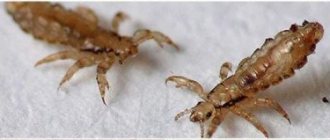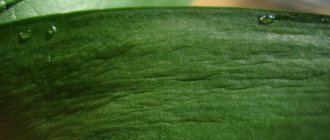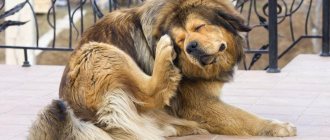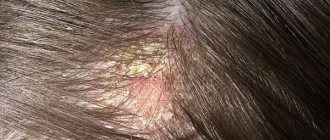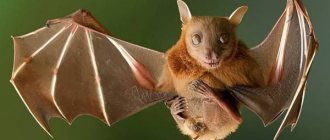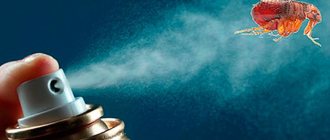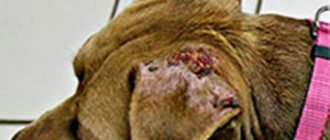Do chinchillas have fleas?
Chinchillas are friendly, undemanding pets.
Animals get sick a little and do not need special care. However, chinchillas sometimes have fleas. For their owners, this information often comes as a surprise. After all, animals are kept in comfortable, homely conditions and do not leave their home.
Also, many believe that chinchillas do not have fleas because rodents have thick fur and bathe in sand. Indeed, animals do not have their own parasites. But pests can be brought in from the street by cats or dogs.
Other routes of infection:
- fleas enter the house by clinging to people's shoes or clothing.
- Attics or basements are favorite habitats for blood-sucking insects. Through cracks and small openings, parasites easily enter a person’s home.
- Sometimes an animal may already be infested with fleas, for example, in a pet store.
- Parasites are often found in hay that is placed in a rodent's cage.
After landing on the body of the intended host, the insects find places where there is the least amount of hair. These are ears, muzzle or paws.
Checking your chinchilla for fleas
Fleas prefer warm, moist places to live, ideally the fur of warm-blooded animals. This applies to the most common types of parasites - cat and dog bloodsuckers, which are no different from each other in their lifestyle. At the same time, they lay eggs on litter and other warm, hidden places. Having brought a playful, affectionate animal into your home, immediately carry out a preventative examination. Especially if he itches and bites the skin. Blood-sucking insects prefer to live on the legs and ears, since there is less fur there compared to the body. If there are no fleas, the skin is clean, smooth, without ulcers or scratches. If the above signs are found, this indicates the presence of parasites.
Important! The assumption that chinchillas do not have fleas is wrong. Their fur is thick and their love of swimming in the sand is considered a good prevention of their appearance. However, if there are insects in the apartment, chinchilla infection is inevitable!
Chinchilla
Chinchilla Farm +79093040488 On the market for more than 16 years
Dear friends! This year has been very difficult for all of us, with a lot of difficulties and disappointments. But it has come to an end, which means a new chapter begins. The Chinchilla Club company sincerely congratulates you on the New Year 2021 and Merry Christmas! First of all, we wish you and your loved ones health, achievement of your goals, family and financial well-being, as well as ordinary happiness. Every year, the Chinchilla Club chinchilla farm pleases with New Year's prices! If you want to increase your livestock or just start your journey in chinchilla breeding, then this offer is especially for you. Until January 15, 2021, there is a 35% discount on chinchillas. IF YOU DO NOT HAVE TIME WITH YOUR PURCHASE, THIS DISCOUNT CAN BE BOOKED! (This promotion does not apply to “Chinchillas in Installments”) details by phone. 89093040488
Installment plan 50%, no commissions and interest for chinchillas. You buy an individual at half the price and repay the debt with young animals raised, or with money within 2 years. Start your profitable business on favorable terms. Details by phone: +79093040488 —
Black Friday at CHINCHILLA CLUB has begun! 40% discount on everything! Details by phone: +79093040488 Hurry, only until 01.12.20
Chinchillas are crepuscular (most active at dawn and dusk) rodents. Habitat is the highlands of the Andes of South America, they live in colonies at high altitudes up to 4270 meters above sea level. Historically, chinchillas lived in an area that included parts of Bolivia, Peru, Argentina and Chile. To date, colonies in the wild are known only in Chile.
Chinchilla (whose name means "little Chincha") is named after the Chincha Indian tribe discovered by the Spaniards in the 1500s, who once wore fur clothing made from the dense, velvety fur of chinchillas. By the end of the 19th century, chinchillas became quite rare due to the great popularity of their soft fur. Nowadays, the fur of chinchillas raised on farms in captivity is used for sewing products.
The chinchilla is currently listed as endangered by the IUCN (International Conservation Commission), due to the loss of more than 90 percent of its population in the wild over the past 15 years. The sharp decline in numbers was caused by uncontrolled hunting of chinchillas by humans.
Until 1996, chinchillas were not listed as endangered, but by 2006 they were listed as endangered, and in 2011 they entered critically endangered status.
Kinds
Comparisons of chinchilla species: There are currently two known living chinchilla species: Chinchilla brevicaudata and Chinchilla lanigera. Chinchilla brevicaudata has a shorter tail, thicker neck and shoulders, and shorter ears than chinchilla lanigera. The first species is currently on the verge of extinction, the second, although rarely found in the wild. Domesticated chinchillas came to us from the lanigera species.
In their native habitat, (due to their skeletal structure) chinchillas prefer to live in burrows or rock crevices. They are quite dexterous and active animals, they move in short leaps and can jump up to 1.8 meters in height. In the wild, natural enemies include birds of prey, skunks, cats, snakes and dogs. In harsh high-altitude conditions, chinchillas' food is rather meager - plant leaves, fruits, seeds of some types of ferns and small insects.
Chinchillas live in social groups that resemble colonies, the correct name being a herd. The number of animals can vary from 14 members to 100 individuals, both for social interaction and also for protection from predators. Chinchillas breed at any time of the year. The gestation period is 104-115 days, longer than most known rodents. Due to the long gestation period, chinchillas are born with full fur, open eyes and are able to move completely independently.
Fur industry
The international trade in chinchilla fur dates back to the 16th century. By this time, chinchilla fur had become the most popular in the fur trade. Chinchilla fur is extremely soft and silky, which is caused by their fur coat sprouting sixty hairs from each hair follicle from the hair root. The zonal coloring of chinchilla fur makes it ideal not only for fur coats, but also for small items of clothing or lining of items such as coats, coats, etc. Due to the relatively small size of the skin, making one chinchilla fur coat may require more than 150 pieces. The active use of fur in large quantities led to the extinction of one species of chinchilla, and served as a serious reason for the extinction of another. Hunting wild chinchillas is prohibited. At the moment, the chinchilla fur industry has completely switched to farm supply.
What makes a chinchilla attractive:
Chinchillas are animals with long ears, large eyes and a thick tail, with unusually dense soft fur. Pile length 2-2.5 cm per 1 sq. cm. There are 15-35 thousand hairs on a chinchilla's body. Thanks to the extraordinary density of the fur, the animal endures the harsh conditions of the wild.
Chinchillas have no odor due to the absence of sebaceous glands, so chinchillas can be easily bred even in an apartment. The bedding in the cage is changed as it gets dirty once every one or two weeks, because... feces do not have the characteristic odor inherent in other types of rodents.
Chinchillas do not shed seasonally, which allows people with allergies to keep them (they do not cause allergies). Animals can shed individual hairs and even tufts of fur only when stressed or excited. In nature, when grabbed by a predator, the chinchilla, leaving shreds of fur, safely escapes from the paws or jaws of the ill-wisher.
The chinchilla is a very clean animal, keeping its fur clean. Fur purity is achieved by taking sand baths, using specialized fine sand, which is naturally volcanic dust. When taking sand baths, she gets rid of excess moisture that is absorbed into her fur from the external environment. Having an unusually dense fur structure, chinchillas do not harbor parasites: fleas, lice, ticks.
Chinchillas adapt well to new owners and do not bite. The animal has sharp front incisors; it can bite or pinch lightly if it suddenly feels aggression or danger from a person, or out of curiosity. But if it senses serious danger, the bite can be quite painful.
Chinchillas are long-lived compared to other rodents. If the life expectancy of, for example, a hamster is 3-4 years, then a chinchilla lives at home for 20 years, under conditions of proper care and balanced nutrition, feeding chinchillas. Our oldest chinchillas are 14 years old and the females are still giving birth to offspring.
Chinchillas respond well to training and education, chinchilla training. They readily respond to nicknames and remember the simplest commands. They get used to the maintenance regime well and quickly: feeding, walking, etc.
Chinchillas do not require a large amount of feeding. Dosed food intake per day is enough: 35-40 grams per day and a little hay.
How fleas get into an apartment
If you are interested in the question of why your chinchilla itches and bites itself, check it for fleas, even if it is the only animal in the house. After all, bloodsuckers can get into a city apartment or private house in several ways:
- flea larvae or young, active insects can be carried on clothes and shoes;
- through ventilation shafts, openings;
- with sand and food, even purchased in a store;
- and the most common option is with pets who prefer warm, damp places for walking - basements, attics, sheds.
Important! If fleas are detected, you should start fighting immediately, because one mature individual lays a large number of eggs per day, which, under favorable conditions, turn into an adult insect within a few days.
How do chinchillas get fleas?
Can a chinchilla get fleas if it is always in a cage and not in contact with other animals? This question worries many owners of cute animals. In fact, bloodsuckers can settle on the thick skin of the animal:
- jumping over other pets;
- coming from attics, basements;
- from sand or hay, which are used for bathing, animal bedding;
- from carpets, upholstered furniture and other items in the house, if the room was infested with fleas even before the animal appeared;
- having settled on an animal in a pet store or market.
Important! Dogs and cats are the main sources of the spread of blood-sucking insects, especially if they are outdoors. Flea collars are not a 100% guarantee of sterility!
Where do fleas come from?
Many owners are concerned about the question: how can a chinchilla get fleas if she never leaves the house and rarely leaves the cage? In fact, being an outdoor animal is not at all necessary to get to know fleas better. It is enough if other animals live in the house besides the chinchilla.
The basement is one of the ways fleas get into the house
- that is especially dangerous in this regard for rodents is a dog that is outside every day and can bring fleas at any moment. The presence of a flea collar on a dog does not guarantee its absolute sterility in this regard. Fleas can still get on your dog on the street. Therefore, it is very important to promptly treat your dog for fleas using traditional or home methods.
- Fleas move quickly and over long distances, sensing the blood of warm-blooded animals. Cats can also spread fleas .
- Other ways fleas enter the house are from basements and attics , where they parasitize stray animals and birds. Ventilation shafts only facilitate this process.
- Sometimes a chinchilla comes into the house already infected with parasites , having received a problem from a guinea pig, which can be eliminated from fleas using folk or store-bought remedies. Therefore, you need to inspect the animal immediately after purchase or even before that.
- Another source of danger is chinchilla hay It may be infested with fleas. Therefore, before putting your favorite treat into the cage, it must be carefully inspected.
What to do if your chinchilla has fleas
Do not worry. This is a serious problem, but completely solvable. You need to go to the pharmacy and buy an anti-flea collar for kittens or small dogs. The use of drops such as “Bars”, “Stronghold” is fraught with poisoning : the rapid metabolism characteristic of rodents makes chinchillas very vulnerable to various chemicals.
Under no circumstances should you use anti-flea shampoos. In nature, chinchillas live in deserts and almost never encounter enough water to wet their fur. Bathing is a serious stress . In addition, the risk of catching a cold .
After putting a collar of a suitable size on the animal, you should proceed to measures aimed at exterminating fleas and their larvae in the home.
- Wash the chinchilla's cage with a solution of tar soap and vinegar.
- Change the sand in the sand bath.
- If there are other animals in the house, treat them for fleas too.
Carefully . If you remove the collar from the animal too early, it may become infected with fleas again. This happens for the reason that the parasite eggs, once on the floor, turn into larvae, which after 7-10 days give rise to a new generation of bloodsuckers.
To avoid re-infection , thoroughly wash the floors with a special product from a veterinary pharmacy. The floor treatment will need to be repeated after 1-2 weeks to destroy the newly hatched larvae and prevent them from pupating and laying eggs.
Inspection rules
To understand whether there is a problem, you need to examine your pet's paws and ears. In these places, the fur is sparse and the skin is thin. Sometimes parasites settle on the stomach and head. A flea can live on a chinchilla's back, but this area is the last area to become infected.
It is extremely rare to see parasites through fur. In the event of any threat, insects quickly hide in thick fur, so a person does not have time to notice them. However, brown feces and flea eggs can be seen on light-colored fur. The latter look like small dark grains.
You can understand that a chinchilla is infected by the following indirect signs:
- Itching. Appears in the early stages of a pet. It disturbs the animal even during sleep.
- Bites. Marks appear on the skin that can be confused with rashes.
- Deterioration in appearance. With severe infection, the body becomes depleted. The chinchilla is losing weight and losing hair.
- Anemia. With the development of anemia, the mucous membranes become pale.
Chinchillas have quite thick fur and it is very difficult to see the insect during inspection.
How do symptoms appear?
The most obvious symptom is a sudden change in behavior. In the early stages, your chinchilla may become overly active. She runs around the cage restlessly and scratches herself. Irritability increases and aggression may appear. Later, due to poor sleep, the rodent becomes lethargic. His daily routine is disrupted. In severe cases, the pet develops apathy. He reacts poorly to attention, food and games.
Bites appear on the animal's skin. They may resemble rashes or warts. If an allergy to flea saliva develops, additional symptoms may develop. The chinchilla may experience discharge from the eyes, sneezing, etc.
Hair loss in an animal may indicate the presence of fleas.
Symptoms of infection
You can understand that a chinchilla has parasites if it:
- changes his behavior beyond recognition, for example, becomes too restless;
- constantly itches or rubs against the sides of the cage;
- combs out wart-like growths;
- scratches and tries to remove small black specks on his body;
- suffers from hair loss and bald spots;
- has too dull coat.
Important! Never use anti-parasite products for cats or dogs on chinchillas. These thick-haired animals are much smaller in weight, so this dosage will be fatal to your rodent. It is better to use a special flea collar.
How to remove fleas from a chinchilla
Veterinarians and owners of furry rodents who have encountered a similar problem know what to do if a chinchilla has fleas. Removal of blood-sucking insects consists of two stages. First, the animal and its cage are disinfested.
Further, if necessary, measures are taken that involve the use of antiparasitic agents.
To get rid of fleas forever, you need to disinfect the entire house. For treatment, you can use special insecticidal or folk remedies.
Other important detoxification activities:
- washing of all bedding and rugs.
- Treating other domestic animals with insecticides.
- Applying antiparasitic agents to all secluded places (floor, baseboards, furniture).
During detoxification procedures, it is necessary to remove animals and people from the home. Several hours after treatment, ventilate the premises, wash floors, surfaces or vacuum them.
For the complete disappearance of fleas, repeated antiparasitic measures are recommended.
Processing the cage and animal
To get rid of pests forever, it is not enough to know how to remove fleas from a chinchilla. For the absolute destruction of insects, the use of insecticides or collars is not enough.
To prevent pests from appearing in your pet again, you need to thoroughly clean the animal’s cage.
For this purpose, the following activities are carried out:
- Sweep out all the trash (droppings, crumbs, leftover food).
- Change hay and sand.
- Treat the cage with a mixture of tar soap and vinegar.
- Boil the litter and disinfect it.
After treatment, it is advisable to place the chinchilla cage in the open air for 2-3 hours. Moreover, it is advisable to place it under the sun's rays.
Antiparasitic agents
After disinfecting the apartment and cage, it is necessary to take the animal to the veterinarian for examination. The doctor will examine the animal and then advise how to rid the chinchilla of fleas.
Often, if parasites are present, the doctor prescribes drops or sprays. Frontline is considered an effective remedy for blood-sucking pests. The drug is produced in the form of a spray or drops, which are used in a minimal dosage.
Other popular flea treatments for chinchillas:
- Advantage (drops);
- Fogger (spray);
- Lawyer (drops);
- Canina Bio (biospray);
- Le Artis (spray);
- Bars (spray);
- Palladium (spray);
- Butoxept (spray).
The chinchilla is a small animal that is very sensitive to chemicals. Therefore, the use of toxic agents in large doses can cause intoxication in a rodent.
The dosage of any antiparasitic agents should be minimal. Veterinarians recommend using doses intended for kittens or puppies.
For those who do not want to take risks in order to prevent rodent poisoning, doctors recommend that they refrain from using chemical antiparasitic drugs. You can simply put a collar on the rodent. It will not harm the chinchilla, as it is considered a less toxic product.
Also, veterinarians do not recommend using pest control shampoos.
After all, the natural habitat of chinchillas is the desert. Rodents never wash themselves. Moreover, water can accumulate in the animal’s dense fur. This will increase the likelihood of your pet getting a cold.
Video
How to remove a chinchilla cage.
The main parasites of chinchillas
There are several types of ectoparasites that are found in chinchillas.
Fleas
These wingless insects jump high and cling to animal fur with their claws and bristles. The flea's body length ranges from 1 to 5 mm, and its mouthparts are designed to pierce the host's skin and feed on blood. They carry pathogens of dangerous diseases such as typhoid, plague, and hepatitis.
Chinchillas can become victims of cat, rabbit and rat parasites. When infected with fleas, the animal itches, hair falls out, and bites resembling warts appear near the face and on the limbs. Insects can be detected by parting the fur.
Lice and lice eaters
Both types of parasites live in the fur of mammals; the sizes of individuals vary from 0.5 to 10 mm. Lice feed on blood, and lice eaters feed on blood and skin particles. They reproduce quickly, laying white eggs - nits that stick tightly to the hair.
These insects also carry infections that are dangerous to people and pets. Their bites cause severe itching and anxiety in animals, as well as scratching on the skin.
Ticks
Chinchillas are parasitized by subcutaneous and ear mites that live in the upper layer of the epidermis. Because of them, bumps, peeling and crusts appear on the skin, the animal often itches and experiences severe discomfort.
The diagnosis is made after microscopic examination of the scraping. Curing a pet from ticks is quite difficult and is often possible only in the initial stages: first, the animal is cut, then washed in a 0.5% bromocyclene solution 4 times at intervals of 8 days.
Prevention of parasite infection in chinchillas
To prevent your pets from becoming infected with ectoparasites and fungi, you need to follow several rules:
- buy quality food and fillers;
- wash the cage and walking areas every day;
- Completely disinfect the cage at least once a month;
- keep chinchillas in a spacious enclosure;
- ventilate the room regularly;
- before adding a new resident to the enclosure, place him in quarantine for 1.5 months;
- wash your hands and change the clothes you came in from the street in if you are going to touch the animals;
- Include essential vitamins and minerals in their diet.
If tests do not show infestation with parasites, the chinchilla may chew out its own fur due to stress associated with moving or moving in with relatives. In this case, she is moved to a separate cage for several days, covered with a dark cloth. Other causes of biting include vitamin deficiency, allergies, and other diseases.
Preventing infections is easier than treating them. Follow the rules for caring for chinchillas, and the animals will be best protected from parasites. If you notice signs of infection in them, contact your veterinarian.
Ringworm or fungus in chinchillas
If your pet itches and bites itself, the cause may be a fungal skin disease - ringworm, or ringworm. Signs that distinguish the disease:
- hair loss in certain areas;
- peeling of the skin;
- formation of crusts and red spots;
- sometimes discharge of pus from wounds.
A chinchilla usually easily tolerates the disease, but if it is neglected, the animal can become completely bald, and the fungus can also affect other organs.
Diagnosis is carried out using an ultraviolet lamp in a dark room: with dermatomycosis, areas of the skin glow green. This test does not detect ringworm caused by some types of fungi; in such cases, skin and hair samples are taken for microbiological analysis.
Factors that increase the risk of disease:
- chronic stress;
- avitaminosis;
- malnutrition;
- high air humidity;
- poor hygiene;
- contact with the vector.
Ringworm is an unpleasant disease, but relatively easy to treat. Therapy is prescribed by a veterinarian; drugs such as clotrimazole, lamisil, exoderil, etc. are usually used. There is a vaccine against fungus that is administered to chinchilla puppies after 6 months.
Ringworm is easily transmitted to humans, so a sick animal should be isolated and touched only with gloves.
Infectious diseases of chinchillas
Infections do not always occur outside the home. Inside its home, a chinchilla can become infected with one or another disease through drink and food, contaminated litter, insect bites (mosquitoes, bedbugs), or contact with another sick pet.
Infectious diseases are especially dangerous, since most of them lead to the death of a pet. However, it is worth noting that any virus can kill a pet if it is allowed to spread.
Infectious diseases that a chinchilla can contract are difficult to cure and can be fatal. These include.
Tuberculosis
Often, tuberculosis infection occurs after drinking contaminated milk or after contact with an already infected chinchilla. The disease is caused by a virus called tuberculosis bacillus. Usually in pets the pulmonary form is found, much less often - the intestinal one.
Tuberculosis is dangerous for humans. An infected pet is lethargic, refuses to play, does not want to take food and water, defecates with diarrhea, loses weight, coughs and sneezes, breathes heavily, and has shortness of breath.
Unfortunately, chinchillas are not treated for tuberculosis. The diagnosis is confirmed by tuberculinization, which is used by veterinarians when a virus is suspected. Pets that have come into contact with an infected animal are kept in quarantine, and the patient must be euthanized.
Listeriosis
Listeriosis is a dangerous disease for furry animals. Pregnant females and their newborn pets are especially susceptible to it. The disease occurs when the infectious agent, Listerella, enters the animal's body through food of animal origin. Listeriosis is dangerous for humans.
Infected chinchillas refuse to eat, have an elevated body temperature (normal is 36-37 degrees), they experience miscarriages and mummification of fetuses, and coordination of movements is impaired (the pet often falls “out of the blue”).
There is no cure for listeriosis; infected people must be euthanized. Chinchillas that have been in contact with patients are kept in quarantine.
Ringworm
The term “lichen” combines two diseases – trichophytosis and microscopy. They are identical in their manifestation, differing only in the pathogens.
Of the frequently occurring infectious diseases, ringworm is the most harmless. It is caused by microscopic fungi that enter the chinchilla's body after contact with a sick animal. The first carrier can be a cat, dog, other animal, sometimes even a person.
Ringworm is noticed in bald areas of the body. Bald patches are usually round, large, inflamed, and the pet constantly scratches them. Lack of treatment results in complete baldness of the body.
Veterinarians detect lichen by scraping analysis. A microscopic examination method is used.
Ringworm can be called harmless only because it can be cured. There are special medications and antifungal ointments for this purpose. Otherwise, the disease is also dangerous for humans, and can lead to the death of young, weak and fragile individuals.
Ringworm cannot be run
If the owner gets sick, it is important to isolate the pet and the person, otherwise treatment may be accompanied by constant re-infection
How to treat
To reliably get rid of fleas, it is not enough to treat only the chinchilla. Insects can remain in bedding and furniture, so comprehensive measures need to be taken. They start by treating the cell. The chinchilla is temporarily placed in another place. It is better to change the litter completely, but if this is not possible, you can remove debris from the old one, boil it and treat it with a disinfectant solution.
The easiest option is to grind tar soap into shavings, dissolve it in water and add a little vinegar. The entire cage and accessories are also treated with the liquid. Sand and hay are changed.
Houses are vacuumed well, moving furniture away and paying attention to upholstery. Bedding is washed in boiling water to kill the fleas. You can do the same with cat and dog bedding if you have any in the house. If it was not possible to get rid of the parasites and the infection recurs, you will have to treat with an insecticidal solution.
The most accessible and simple remedy is Bars spray. You may have to go somewhere for a day and take your pets to avoid intoxication. Sprays are used to treat the bottoms of beds and sofas, mattresses, crevices behind baseboards and kitchen cabinets, etc. After 10 days, the procedure is repeated to destroy the hatched individuals.
Special antiparasitic agents are produced for chinchillas. Some owners use medications for cats and dogs, but the dosage of active substances in them is different. This may cause side effects. It is recommended to use drugs for rodents; in extreme cases, a minimum dose should be given.
As an alternative, you can purchase a collar for cats and dogs. It contains less active substances. It is not recommended to use flea shampoos, because... A chinchilla may catch a cold after bathing. If there are other animals in the house, they also need to be treated.
One of the options for protecting against fleas is to put a parasite collar on your chinchilla.
Chinchilla treatment
If fleas are found on the animal, it is necessary to begin treatment. Some owners try flea medications designed for cats and dogs, especially if they are available in the home. But we must remember that the chinchilla is a small animal. And the dose of the chemical contained in drops for dogs and cats may be too much for her. This will cause poisoning of the animal. Fluffies themselves are also very sensitive to chemicals.
Therefore, you should not risk your pet’s health and prescribe treatment for it. Powder, sprays and drops are undesirable for them. If fleas are found on chinchillas, it is better to wear a flea collar. It is less toxic and therefore will not harm the animal. Flea collars for cats and small dogs are quite suitable for chinchillas.
Treating a rodent for fleas
Only large-scale disinfection measures will allow you to get rid of fleas not only on the animal’s skin, but throughout the entire apartment. Immediately after detection, it is necessary to remove all inhabitants from the house and carry out disinfection with special preparations - spray or aerosol. You need to carefully treat the areas behind the baseboards, floor cracks, carpets, and upholstered furniture. After this, the apartment is thoroughly cleaned with washing and using a vacuum cleaner. All pets are also treated with insecticides and wearing flea collars.
Chinchillas have fleas, what not to do?
- Use anti-parasitic shampoos designed for larger pets.
- Bathing an animal, for which getting its fur wet can result not only in serious stress, but also a cold.
- Use chemicals such as Bars or Stronghold, which can cause poisoning.
Important! 1-2 treatments of the apartment will be enough for the insects to disappear!
Flea remedies
When using antiparasitic products intended for cats and dogs, it is worth keeping in mind that the chinchilla is much smaller in size than other pets. This means that the dose of the chemical must be reduced. Special sprays and drops can cause significant harm to the animal. Therefore, the best option would be a special collar that is used for cats and dogs. The product is less toxic compared to chemicals and safe for health.
Prevention of re-infection
To prevent the appearance of pests in hamsters, you must adhere to the following recommendations:
- if a cat or dog lives in the house in addition to a rodent, they should be wearing a flea collar before going for a walk;
- All pets should be bathed using anti-parasitic shampoo;
- inspect the hamster’s fur at least 2-4 times a week for the presence of fleas;
- put peppermint and wormwood leaves in a cage and distribute them throughout the apartment, which repel parasites with a pungent odor;
- maintain cleanliness in the rodent's house;
- disinfect cages, apartments and furniture using insecticidal preparations.
Hamsters are highly clean, so they are not often exposed to parasitic infestations. In most cases, they become infected or cats.
Previous FleasHow to get rid of fleas in guinea pigs Next FleasAre pigeon fleas dangerous for humans
Preventive examination
As soon as the animal gets into your home, carefully examine its paws and ears. The fur on these parts of the animal’s body is much less dense than on the body, and parasites prefer to feed there. The skin is clean, no ulcers or scratches found, no insects? Everything is fine. Your animal is healthy.
You can tell that a chinchilla has fleas by indirect signs:
- The chinchilla experiences constant itching and cannot sleep peacefully. Losing weight.
- Dermatitis appears on the skin.
- The fur is falling off.
- Black specks are visible in the fur - flea droppings.
- Anemia occurs - the nose, gums and other mucous membranes turn pale, the animal weakens.
Attention. Many believe that chinchillas do not have fleas, since the thickness of their fur and love for swimming in fine sand prevent parasites from settling in their fur coat. But it is not so. They do not have their own parasites, but cat and dog fleas brought in from the street do not bypass any potential hosts.
Image of the enemy
Chinchillas are parasitized by cat and dog fleas of the genus Ctenocephalides felis . They are several millimeters in size and look like black dots. The flea loves damp and warm places. Needless to say, a chinchilla’s cage can create almost ideal conditions for fleas. The parasite feeds on the blood of animals, and can live for almost a year without food.
Chinchillas are parasitized by cat and dog fleas
Fleas lay eggs not on animals, but on litter, behind baseboards, in cracks, in carpeting. Each flea is capable of laying up to two thousand eggs. It follows that if you do not fight fleas, they will fill the entire house extremely quickly.
Can a person become infected from a sick animal?
Humans can only become infected by fleas of the species Pulex irritans. Therefore, there is a chance of becoming infected with parasites, but it is very small. You may also simply be a carrier of these insects. But you should still be careful, as the flea can carry plague and rabies. Therefore, it is important to regularly carry out preventive measures.
Sources
- https://parazitdoma.ru/blohi/u-shinshilly-chto-delat
- https://klopkan.ru/blohi/vsyo-o-blohah/byvayut-li-blohi-u-shinshill/
- https://hlopklop.com/blohi/blohi-u-shinshill.html
- https://lifeinsect.ru/blohi-u-shinshilly.html
- https://homjakam.ru/shinshilla/zdorovie/cheshetsya-ili-pokusyvaet-sebya
- https://combat-dez.ru/prichiny-i-simptomy-poiavleniia-bloh-y-shinshill/
- https://stop-klopam.ru/blohi-u-zhivotnyh/chto-delat-esli-u-shinshilly-poyavilis-blohi
- https://pets2.me/bok/1629-kak-vyvesti-bloh-u-shinshilly.html
[collapse]


